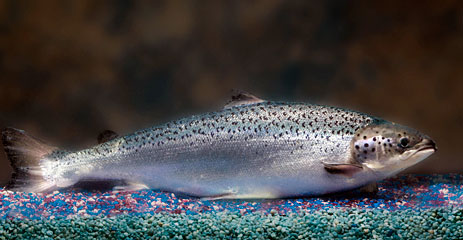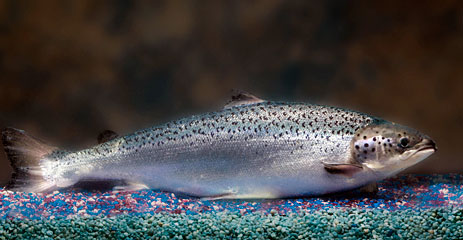 Ready to scale up: The AquAdvantage salmon.AquaBounty photoSen. Mark Begich (D-Alaska) is right: If ever a genetically engineered product deserved the “Frankenfood” label, it’s the genetically modified Atlantic salmon created by the Massachusetts-based company AquaBounty. These salmon, which contain growth genes from Chinook salmon as well as the ocean pout, are truly monsters. They grow faster and end up larger than normal Atlantic salmon. And they just received preliminary approval from the FDA; the final nod is likely to come in the next month.
Ready to scale up: The AquAdvantage salmon.AquaBounty photoSen. Mark Begich (D-Alaska) is right: If ever a genetically engineered product deserved the “Frankenfood” label, it’s the genetically modified Atlantic salmon created by the Massachusetts-based company AquaBounty. These salmon, which contain growth genes from Chinook salmon as well as the ocean pout, are truly monsters. They grow faster and end up larger than normal Atlantic salmon. And they just received preliminary approval from the FDA; the final nod is likely to come in the next month.
I make no fishbones about the fact that I have a deep skepticism of transgenic food. And it’s not because I don’t “trust” the concept in some way. What I don’t trust is a regulatory system that puts the companies that want to sell you their genetically engineering product in charge of proving its safety. Can no one in charge see the flaw in this logic?
This standard doesn’t just apply to genetically engineered food, of course. It’s true for drugs and industrial chemicals as well. Indeed, an entire “product defense” industry has sprouted up to help corporations publish favorable and, sometimes misleading, science with which to gain government approvals and fend off safety concerns.
The current process surrounding GE salmon is but one example of the perverted regulatory process now in place at the FDA (as well as the EPA). Thanks to outdated laws and pernicious incentives, foods like GE salmon are evaluated as “veterinary drugs” and companies’ own research is considered “objective.”
So we should be thankful that blogger Jill Richardson put together this careful and lengthy review for Alternet of the safety studies behind this new GE salmon. Unfortunately, the news is not good. Consumers Union senior scientist and biologist Dr. Michael Hansen characterizes the supporting science performed by AquaBounty to Richardson as “sloppy,” “misleading,” and “woefully inadequate.”
One thing that stood out to me is the shockingly routine dismissal by the FDA review board of a high “physical deformity” rate among the genetically engineered fish. You’d think something like that would raise eyebrows among regulators. However, as you’ll see below, AquaBounty found an effective, if scientifically unsound, way to downplay these unfortunate side effects of their genetic manipulations.
The ultimate goal, as far as AquaBounty is concerned, is to publish results that let advocates of genetically engineered food declare, as this one did today in the pages of the Los Angeles Times, that the genetic manipulation of the fish “confers no detectable difference in its appearance, taste or nutritional value.” (Aside from the small problem that loads of the salmon were deformed, that is.)
Yet AquaBounty’s submissions to the FDA were apparently sufficient to convince the FDA’s Veterinary Medicine Advisory Committee of the salmon’s safety. To accomplish this, AquaBounty apparently had to take a few shortcuts. Here are some of the questionable scientific techniques that have CU’s Michael Hansen so upset:
- Small sample size: Some tests, such as those used to determine rates of deformity in the fish, had sample sizes as small as six fish. At least 30 would be need for a statistically significant finding.
- Non-random samples: The company culled deformed fish out of the test samples and didn’t identify other samples as randomly selected. This is a big scientific no-no. If you’re cherry-picking, you’re cheating.
- Ignoring bad years in favor of good years: AquaBounty’s test were conducted over several years, yet most of the results were from 2007 — the best year for the fish and the worst year for the non-genetically engineered “control” fish. Data from 2005, where the GE salmon fared poorly, showing high rates of deformities, were strangely absent from AquaBounty’s results.
- Setting detection limits too high: In tests for the presence of growth hormone, AquaBounty seems to have set the limits too high, thus ensuring that all their fish would “pass” the test. As Hansen described it, it’s like a cop with a radar gun that doesn’t go below 120 mph marveling “See! No one’s speeding!” Even then, several GE fish still showed detectable levels of an “insulin-like growth factor” — a potential cancer risk.
- Using non-standard measures: In tests to indicate “allergenicity” of the salmon, AquaBounty used something it called “relative allergic potency,” which does not appear to have any scientific basis. Still, the GE salmon registered high levels of this measure.
- Not bothering to use current technology: There are far better techniques for measuring a food’s potential allergenicity than the ones AquaBounty chose to use.
Does this sound like “junk science”? I think so.
We can and should have the debate over the wisdom of introducing wholly novel, transgenic products into the food system, not to mention into our bellies. But this particular fish story is really about a broken and corrupt regulatory process. Clearly, the FDA wants to approve these products. They want to “help” their “customers,” aka food companies, and no longer seem to have public safety at the top of their priority list.
The FDA will soon hold public meetings for the GE salmon: one on September 19 to review the science; if it is approved, then a second meeting on the 21st will cover whether it should be labeled and how. Let’s hope that someone calls bullshit on the junk science behind AquaBounty’s product, and that the agency listens.
Get Off Your Ass Alert: If the AquAdvantage salmon gets approved, the FDA will also take into consideration public comments as to whether “we should require labeling for such food beyond that required for food from other varieties of Atlantic salmon,” it says. You can tell the agency your answer to that question via written comments until November 22.


